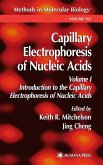The development of PCR, which enables extremely small amounts of DNA to be amplified, led to the rapid development of a multiplicity of a- lytical procedures that permit use of this new resource for the analysis of genetic variation and for the detection of disease-causing mutations. The advent of capillary electrophoresis (CE), with its power to separate and a- lyze very small amounts of DNA, has also stimulated researchers to develop analytical procedures for the CE format. The advantages of CE in terms of speed and reproducibility of analyses are manifold. Furthermore, the high s- sitivity of detection, and the ability to increase sample throughput with par- lel analysis, has led to the creation of a full range of analysis of DNA molecules, from modified DNA adducts and single-strand oligonucleotides through PCR-amplified DNA fragments and whole chromosomes. Capillary Elect- phoresis of Nucleic Acids focuses on analytical protocols that can be used for detection and analysis of mutations and modification, from precise DNA loci through entire genomes of organisms. Important practical considerations for CE, such as the choice of separation media, electrophoresis conditions, and the influence of buffer additives and dyes on DNA mobility, are discussed in several key chapters and within particular applications.
Hinweis: Dieser Artikel kann nur an eine deutsche Lieferadresse ausgeliefert werden.
Hinweis: Dieser Artikel kann nur an eine deutsche Lieferadresse ausgeliefert werden.
"These volumes comprehensively and accurately present CE technology and techniques with an emphasis on providing an understanding of the theory and instrumentation (Vol. 1), as well as detailed examples of successful analytical protocols (both volumes)...Chapters on the use of microchip and mass spectrometric detection are also included...Although numerous experimental protocols can be found in Vol. 1, it is clear that the intent is to communicate the underlying theory and capability of CE for separations. Vol. 1 should be of interest to the novice as well as the expert. In Vol. 2, each of the 31 chapters present specific examples of the use of CE...Nonetheless, these two volumes of the Methods in Molecular Biology series offer a representative and needed overview of the current theory and practice of CE of nucleic acids. These texts should prove very useful to both active investigators in this area and those seeking to learn more about the use and and capability of CE." - Clinical Chemistry Review for both volumes: "This two-volume set of books comprises 64 chapters of protocols for the analysis of just about every form and size of nucleic acids that one can imagine. Thus it rates near an "A" for its comprehensiveness." -Analytical Chemistry "...rates near an "A" for its comprehensiveness." - Analytical Chemistry








